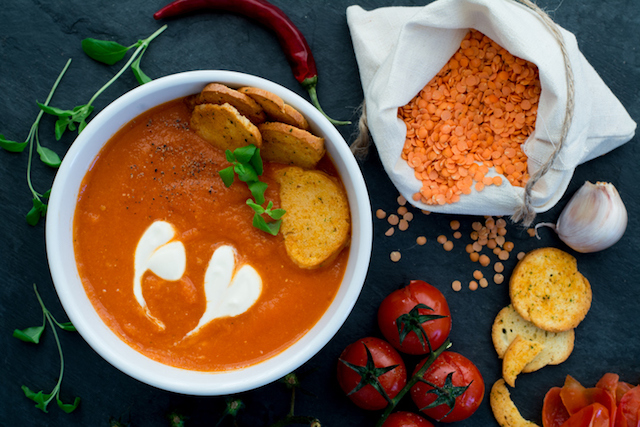Lentils – my smart legume

Lentils are one of the oldest legumes and integral to the cuisines of the Middle East, India and Eastern Europe. They are well and truly worth including in your everyday eating for lots and lots of reasons.
Nutritious, versatile and budget-friendly
If you’re vegetarian, it’s definitely worth getting to know how to cook lentils as they are a wonderful protein source. If you eat meat, they extend the protein of meat or chicken and save you money while still allowing you to eat a nutritious, high-protein meal.
Lentils have almost no fat and are packed with fibre, protein, B vitamins and minerals like potassium, magnesium and zinc. Like all legumes or pulses, they are gluten-free. However, to my mind, their greatest benefit is that lentils boast one of the lowest Glycemic Index (GI) of any starchy food, meaning they fill you up and keep hunger away. This is primarily because their starch breaks down relatively slowly or incompletely during cooking and they contain enzyme inhibitors that also slow digestion.
How much to eat?
- Aim for two serves or more per week as a starchy vegetable alternative—more if you are vegetarian.
- One serve is half a cup of cooked legumes (around 100 g), preferably with no added salt.
Red, brown or Puy?
Lentils come in lots of colours. I like the split red lentils as they soak up liquid and ‘disappear’ whilst thickening soups and slow-cooked recipes. They’re good for making a side of mash or dhal. Actually even though they’re called red, they can come in shades of orange and yellow.
Brown lentils (also sold as green lentils) hold their shape and stay intact during cooking. French slate-green or Puy lentils are tiny and stay firm too.
All colours and types of dried lentils are similar in nutritional value.

My smart carb – lentils
Lentils are the easiest of all the legumes to cook as they do not need to be soaked first. Just measure out and throw into your curry, casserole or soup. Being small, they cook quickly so there’s no excuse not to add them to soups, salads and slow-cooked dinners.
They also don’t seem to produce as much flatulence as other beans, another bonus when you first start eating them. They are also easy to digest so make a nice entry point if you’re new to beans.
To cook dried lentils:
- Rinse first, then place in a large pot and cover well with water. You can use stock for more flavour or add herbs such as a bay leaf or garlic to the water.
- Place a lid on the pot and bring to the boil over high heat.
- Turn heat down to a simmer and cook, half-covered for 10 or 20 minutes, depending on the type of lentil, how old they are and how well you like them cooked. The older they are, the longer they take to cook.
Thanks to dietitian Caroline Trickey for information from her great book ‘Veggie-Licious’
Cooking with lentils
Here are 8 ways I use lentils in the kitchen:
- In purées and dips as they are quite ‘mushy’ when cooked. Read more here.
- Add half a cup of red lentils to the meat sauce when making spaghetti Bolognese,
- Enjoy a lentil or split pea soup as a winter warmer
- Lentil burgers or patties
- Lentil Bolognese
- Lentil loaf baked
- Mash or dahl
Bottom line
Lentils are definitely a smart carb, and my pick from amongst the legumes, especially for beginner cooks. Learn to love them, especially if you have diabetes or need to shed weight. No matter how much you eat, they have only a small effect on your blood glucose levels.
Related links
- A 2018 study confirms what I've said above and shows that replacing half of the carbohydrate from high-GI foods such as potato and rice with lentils significantly reduces the rise in blood glucose after a meal in healthy adults.
- Eat for Health (government website)
- Grains and Legumes Nutrition Council








